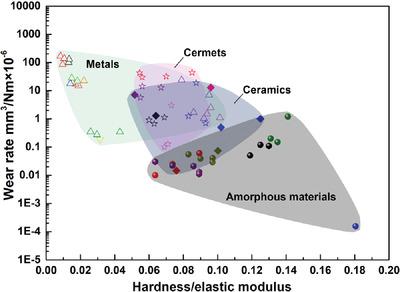Our official English website, www.x-mol.net, welcomes your
feedback! (Note: you will need to create a separate account there.)
Recent Progress on Wear-Resistant Materials: Designs, Properties, and Applications
Advanced Science ( IF 14.3 ) Pub Date : 2021-03-24 , DOI: 10.1002/advs.202003739 Wenzheng Zhai 1 , Lichun Bai 2 , Runhua Zhou 3 , Xueling Fan 4 , Guozheng Kang 5 , Yong Liu 3 , Kun Zhou 6, 7
Advanced Science ( IF 14.3 ) Pub Date : 2021-03-24 , DOI: 10.1002/advs.202003739 Wenzheng Zhai 1 , Lichun Bai 2 , Runhua Zhou 3 , Xueling Fan 4 , Guozheng Kang 5 , Yong Liu 3 , Kun Zhou 6, 7
Affiliation

|
There has been tremendous interest in the development of different innovative wear-resistant materials, which can help to reduce energy losses resulted from friction and wear by ≈40% over the next 10–15 years. This paper provides a comprehensive review of the recent progress on designs, properties, and applications of wear-resistant materials, starting with an introduction of various advanced technologies for the fabrication of wear-resistant materials and anti-wear structures with their wear mechanisms. Typical strategies of surface engineering and matrix strengthening for the development of wear-resistant materials are then analyzed, focusing on the development of coatings, surface texturing, surface hardening, architecture, and the exploration of matrix compositions, microstructures, and reinforcements. Afterward, the relationship between the wear resistance of a material and its intrinsic properties including hardness, stiffness, strength, and cyclic plasticity is discussed with underlying mechanisms, such as the lattice distortion effect, bonding strength effect, grain size effect, precipitation effect, grain boundary effect, dislocation or twinning effect. A wide range of fundamental applications, specifically in aerospace components, automobile parts, wind turbines, micro-/nano-electromechanical systems, atomic force microscopes, and biomedical devices are highlighted. This review is concluded with prospects on challenges and future directions in this critical field.
中文翻译:

耐磨材料的最新进展:设计、性能和应用
人们对开发不同的创新耐磨材料产生了极大的兴趣,这些材料有助于在未来 10-15 年内将摩擦和磨损造成的能量损失减少约 40%。本文全面回顾了耐磨材料的设计、性能和应用的最新进展,首先介绍了各种先进的耐磨材料和抗磨结构制造技术及其磨损机制。然后分析了耐磨材料开发的表面工程和基体强化的典型策略,重点是涂层、表面纹理、表面硬化、结构的开发以及基体成分、微观结构和增强材料的探索。然后,讨论了材料的耐磨性与其固有性能(包括硬度、刚度、强度和循环塑性)之间的关系以及潜在机制,例如晶格畸变效应、结合强度效应、晶粒尺寸效应、沉淀效应、晶粒效应等。边界效应、位错或孪生效应。重点介绍了广泛的基础应用,特别是航空航天部件、汽车零部件、风力涡轮机、微/纳米机电系统、原子力显微镜和生物医学设备。本次审查最后对这一关键领域的挑战和未来方向进行了展望。
更新日期:2021-03-24
中文翻译:

耐磨材料的最新进展:设计、性能和应用
人们对开发不同的创新耐磨材料产生了极大的兴趣,这些材料有助于在未来 10-15 年内将摩擦和磨损造成的能量损失减少约 40%。本文全面回顾了耐磨材料的设计、性能和应用的最新进展,首先介绍了各种先进的耐磨材料和抗磨结构制造技术及其磨损机制。然后分析了耐磨材料开发的表面工程和基体强化的典型策略,重点是涂层、表面纹理、表面硬化、结构的开发以及基体成分、微观结构和增强材料的探索。然后,讨论了材料的耐磨性与其固有性能(包括硬度、刚度、强度和循环塑性)之间的关系以及潜在机制,例如晶格畸变效应、结合强度效应、晶粒尺寸效应、沉淀效应、晶粒效应等。边界效应、位错或孪生效应。重点介绍了广泛的基础应用,特别是航空航天部件、汽车零部件、风力涡轮机、微/纳米机电系统、原子力显微镜和生物医学设备。本次审查最后对这一关键领域的挑战和未来方向进行了展望。


















































 京公网安备 11010802027423号
京公网安备 11010802027423号